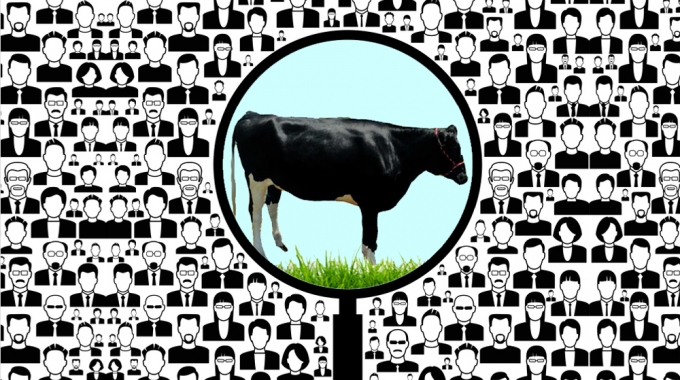
The folks at NPR Planet Money conducted an online experiment to test the wisdom of crowds. They asked their listeners to estimate the weight of a cow from a photo posted online. They received 17,205 guesses. They then took the average of the submissions and compared them to the actual weight of the cow. The goal: to see if there is really wisdom in crowds.
A parallel study was conducted by Unanimous A.I., a Silicon Valley company specializing in Collective Intelligence. The goal was to assess how “human swarms” compare to traditional “crowds”. When polling a crowd, you take a statistical average of votes from a group of disconnected individuals. When fielding a swarm, you convene a group to participate simultaneously, connected by networking software so they can make their prediction together as unified system. Thus, while a crowd gives the “average opinion” of the group, a swarm gives a “convergent opinion”, i.e., the opinion the group can best agree upon. So, how did they compare?
We should note that the NPR experiment is based on a 1906 study by British scientist Francis Galton. While at a farming fair in England, he came across a weight-judging contest for a large ox. A total of 787 people submitted their best guess. Being a curious scientist, Galton asked for the data and computed the statistical average. It came out to 1,198 pounds. The actual weight 1,198 pounds! Thus, while the vast majority of guesses were way off, as a crowd the group was amazingly accurate.
So, how did the NPR respondents do? While today’s population is less familiar with farming than the villagers in 1906, and judging a cow’s weight from a photo is harder than in person, by polling 17,000 individuals, NPR demonstrated the wisdom of crowds. The average of the estimates was 1,287 lbs, which is only 68 lbs off from the cow’s true weight of 1,355 lbs (5.0% error). While not as accurate as the Galton study in 1906, it’s an impressive result for a group with little knowledge of cows and only a photo for reference.
What about the swarm? The folks at Unanimous A.I. asked a group of 49 randomly chosen users to form a swarm using the UNU platform for collective intelligence. The group was asked to view the same photo that the NPR respondents viewed and make the same prediction, but not as isolated individuals — as a real-time dynamic system that responds by thinking as one. The big question, of course, is can such a small group of people get even close to the right answer?
The swarm predicted the weight of the cow to be 1,250 pounds. Thus the swarm of 49 people, thinking in unison, produced a result that was less than 3% different than the prediction made by 17,205 poll respondents. This suggests that swarms are potentially far more efficient than crowds, producing similar results with a group that’s only a tiny fraction of the size. Additional studies need to be conducted with larger swarms to assess how many people need to think in unison to exceed the ability of a large crowd, but the result is exciting. See a replay of the swarm below:
To further test if swarms are more accurate than polls, researchers at Unanimous polled the participants in the swarming experiment before they took part in the swarm. Taking the average prediction of this small crowd, the group estimated the weight of the cow to be 1,137 lbs, off by 16.1% from the true weight of the cow. But again, those same individuals, when working in synchrony as a unified swarm, produced an estimate of 1250 lbs, off by only 7.7%. This supports the finding that when working as a unified system, groups make better predictions.
Of course, if you want to increase the accuracy of a poll, you can boost the number of respondents. NPR confirmed this with their massive group of 17,205 participants which achieved a prediction that was only off by 5.0% from the true weight of the cow.
That said, Unanimous A.I.’s swarm of only 49 people was almost as accurate. Furthermore, the swarm was assembled in under 10 minutes, which is a big savings of time and effort compared to the full week NPR used to collect 17,000 estimates. While further research is required to determine the size of a swarm needed to match or exceed the poll results of a huge crowd, these initial results suggest that human swarming is a very promising method for harnessing the intelligence of groups.
Want to participate in a swarm? Join the UNU.ai beta program by clicking here. It’s free, fun, and totally anonymous.




